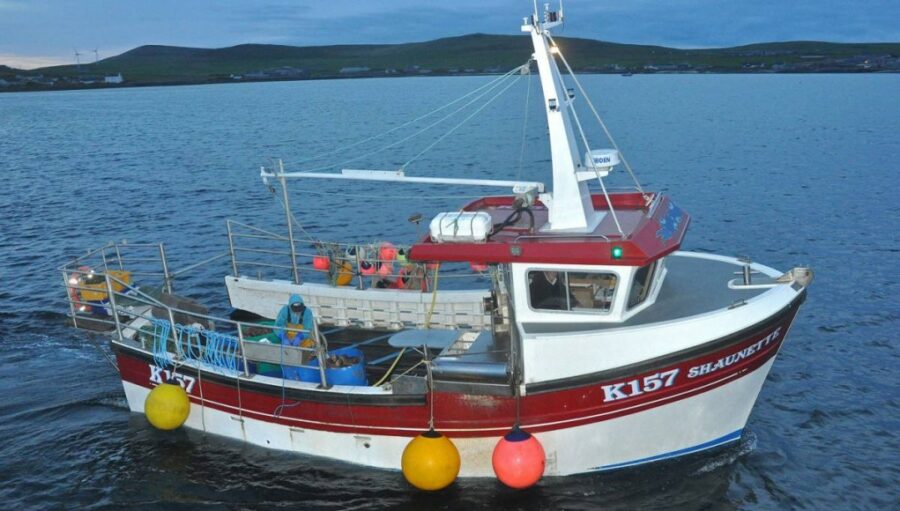This is the third, and final, part of the Fishing News Orkney feature by David Linkie. Catch up on parts one and two if you missed them!
Fishing of key importance on Westray
Although less than 10 miles long and two miles wide, and home to fewer than 600 residents, the island of Westray continues to be a key fishing centre in Orkney.
The fact that Westray is situated 25 miles and a two-hour ferry crossing north of Kirkwall – further compounding transport logistics – highlights the determination that local fishermen rely on every day of the year, to maintain their sole way of life and source of income.
While two creel boats work from moorings near the ferry terminal at Rapness, most Westray boats fish from the well-sheltered harbour of Pierowall on the north-east corner of the island.
During poor weather, Pierowall harbour and the outlying bay frequently provide welcome sanctuary for a variety of larger boats, including Anglo-Spanish longliners.
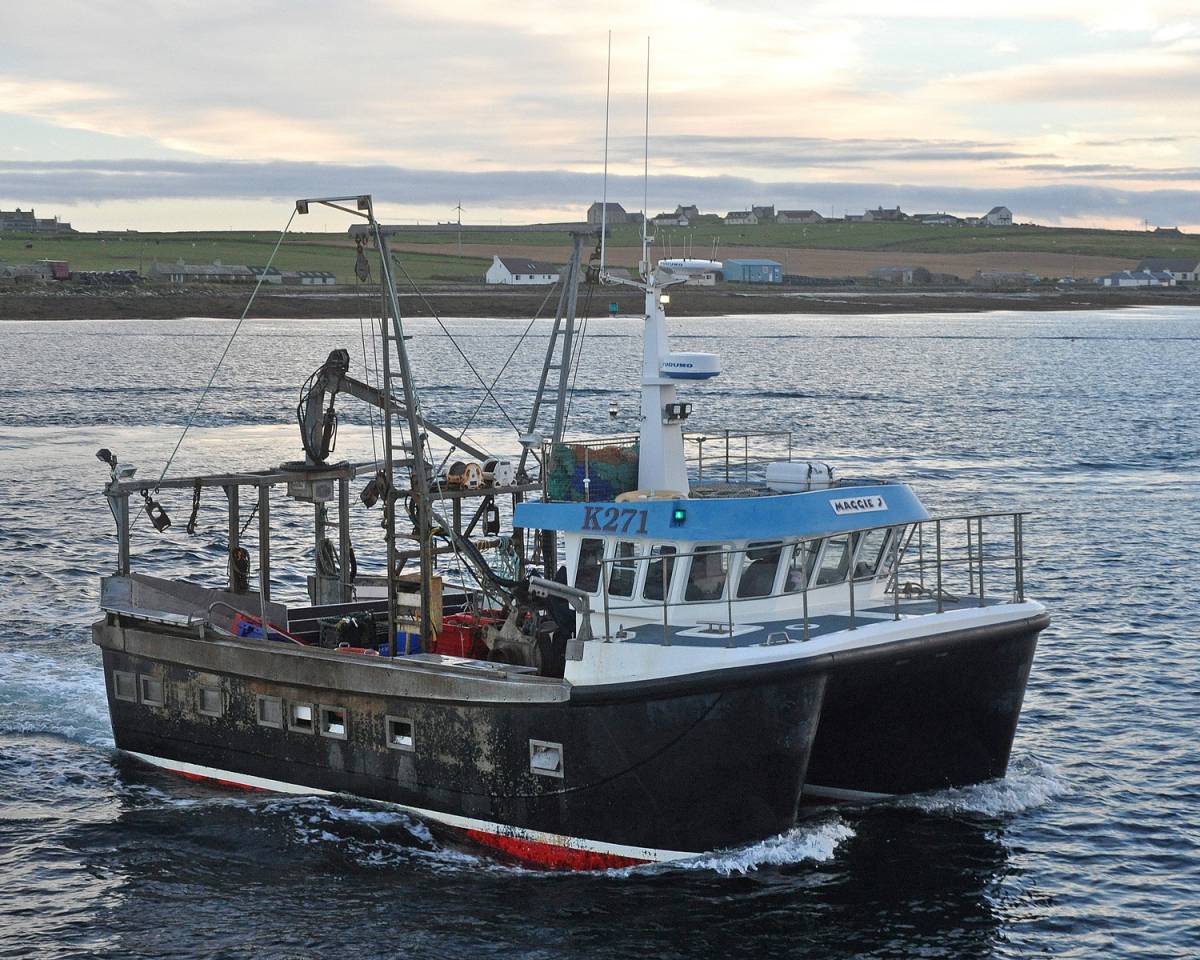
Robbie Hutchinson’s versatile crabber, scalloper and prawn/squid trawler, Maggie J, returns to Pierowall harbour…
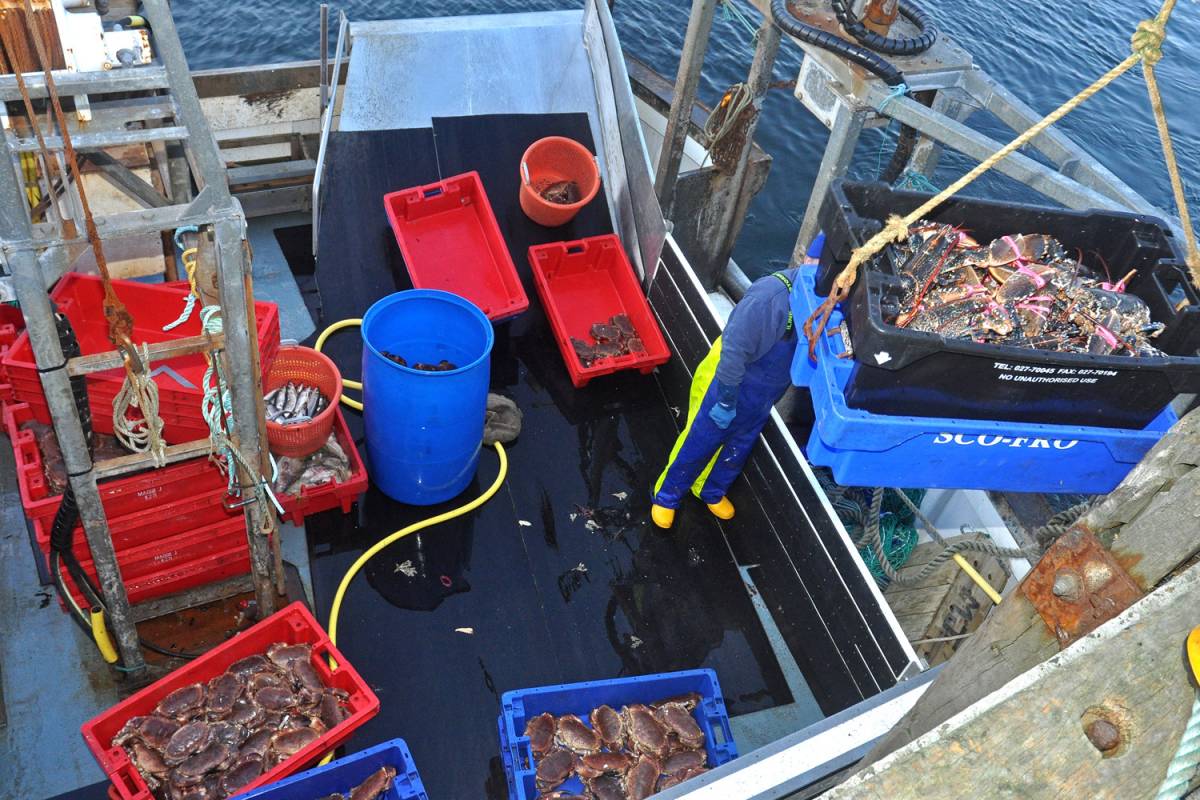
… to land the day’s catch.
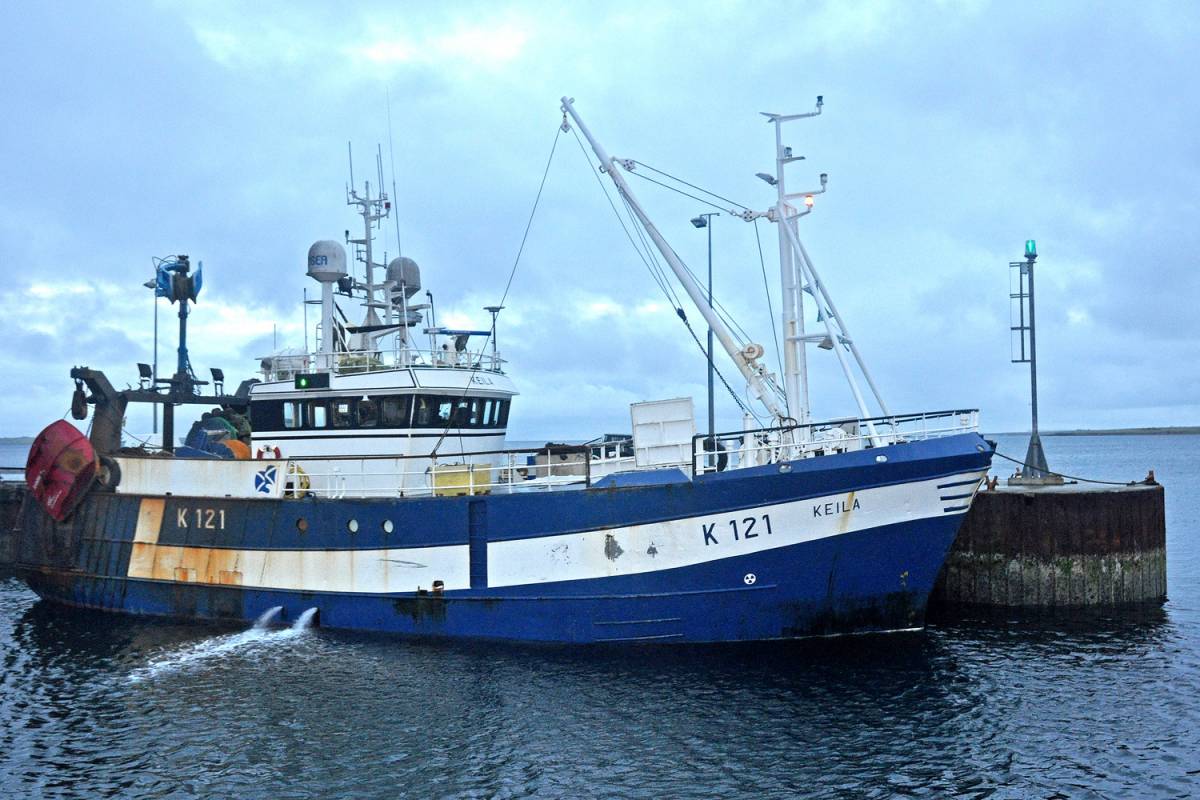
Westray skipper Tommy Tulloch’s whitefish trawler Keila berthed at Pierowall – the 27.3m vessel is scheduled to be replaced in 18 months’ time with a similar-sized purpose-built stern trawler.
As with most UK harbours, Pierowall has experienced a considerable transition over the past 20 years, during which time shellfish provided important underlying stability. This proved invaluable at the time, when the local whitefish fleet experienced a drastic demise.
Westray will receive a welcome boost in September 2017, when skipper Tommy Tulloch is scheduled to berth a new 28m whitefish stern trawler in Pierowall harbour for the first time. This will follow her delivery trip home from Hvide Sande in Denmark, where the fully-shelterdecked vessel, which will replace the 27.3m single-rig trawler Kelia K 121, is to be built by Vestværftet ApS (Fishing News, 21 January).
For the past decade, static gear fishing has provided an invaluable mainstay for Westray, and one that continues to attract investment, in close alignment with catching and marketing opportunities. Such balance is of paramount importance, given the transport costs incurred when initially sourcing creel bait and subsequently selling the resultant catches.
Six creel boats, Kingfisher (skipper John Kent), Lady K (Heddle Costie), Maggie J (Robbie Hutchinson), New Venture (Paul and Adam Tulloch), Rona (Gordon Wendall), and Shaunette (Jocky Harkness) work all year round from Pierowall harbour. Papa Westray skipper Douglas Hourston, who fishes the catamaran Dawn Harvest K 1156, also lands into Pierowall daily before returning home across the one-mile stretch of water. This crossing can also be made by plane, and it is recognised as being the shortest scheduled flight in the world, with a distance of 1.7 miles and a scheduled flight time, including taxiing, of two minutes.
The most recent addition to the Westray static-gear fleet is the former Fraserburgh-owned Maxus 9.8m Still Game FR 29, which Pierowall skipper Jocky Harcus bought in the middle of last year to replace the Cygnus 44 Shaunette K 157, which was sold to Seamus Kavanagh of Arranmore, Co Donegal. Now renamed after her predecessor, the new Shaunette, which was built by G Smyth Boats of Kilkeel less than three years ago, features a Perkins Sabre 130 engine (96kW @ 2100rpm) and a 1t Spencer Carter pot hauler.
Fishing brown crab down to depths of 50 fathoms towards the Papa Bank north-west of Westray is the main form of activity for the bigger Pierowall boats.
However, the variety of grounds available, due to the close arrangement of islands east to North Ronaldsay, which can provide a degree of shelter on poorer days, are also of considerable importance to the local shellfish fleet.
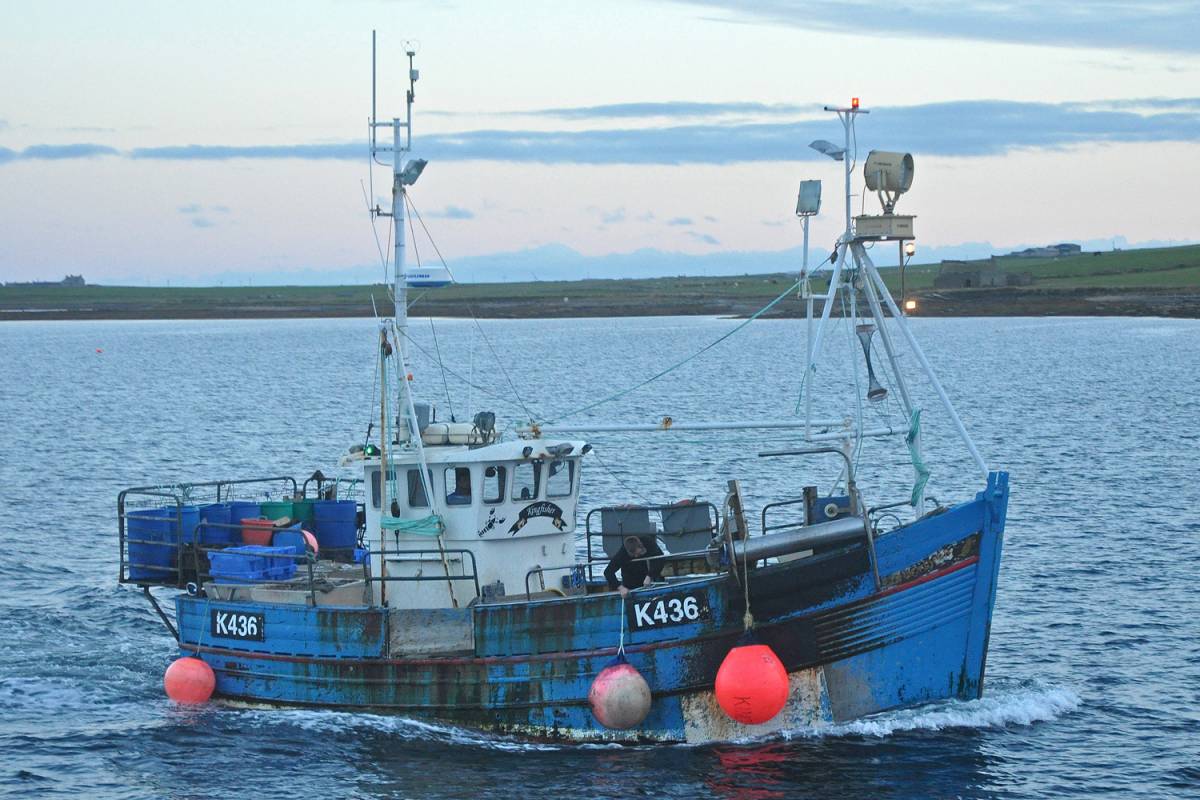
Kingfisher heads in to Pierowall from the crab grounds.
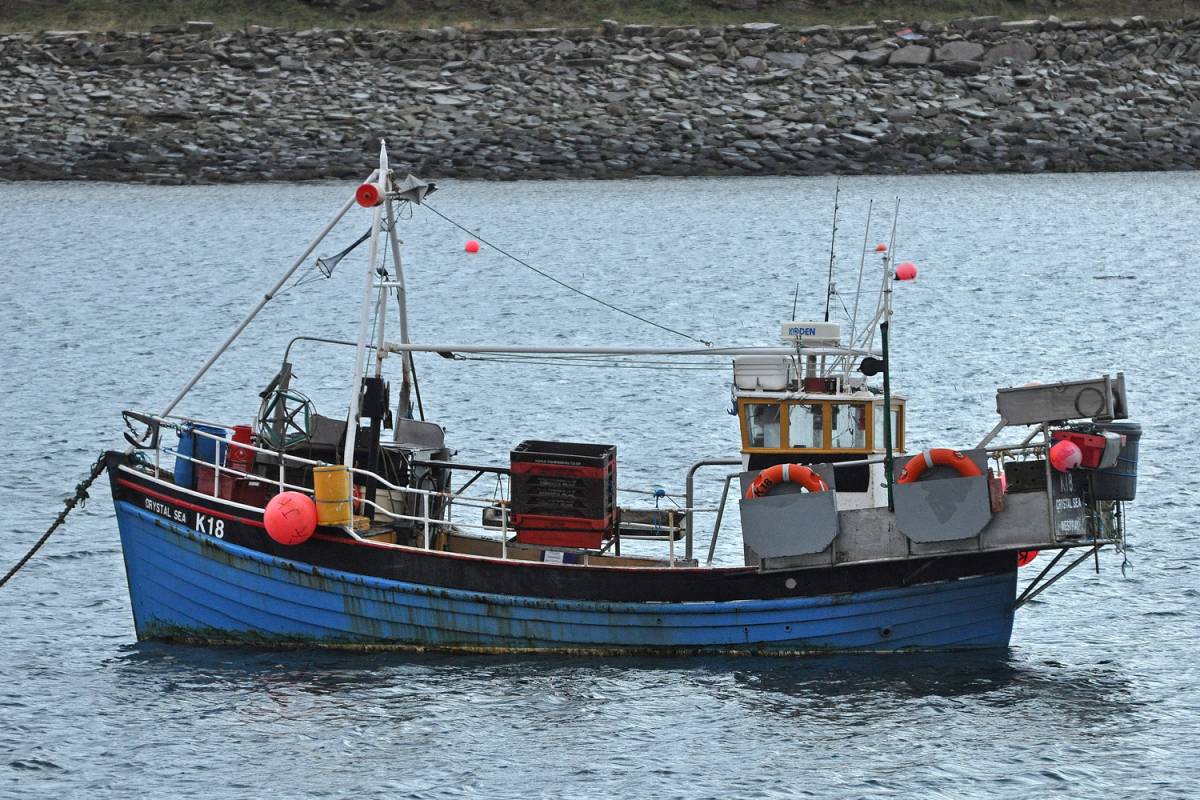
Crystal Sea…

… and Valhalla work from moorings at Rapness.
While daily catches of fresh brown crab, all of which are cooked and cleaned in the Westray Processors Ltd factory, located less than 100m from where they are put ashore at Pierowall harbour, form the year-round backbone of shellfish landings. Lobsters and velvet crabs also provide important, more seasonal, diversity for local creel boats.
Again, the relative closeness of the grounds allows some boats, particularly semi-displacement vessels, to work their way around a number of small islands during the course of a day. This high degree of movement also plays an important role in promoting sustainable fishing and stock conservation, by enabling skippers to continually move grounds, rather than remaining in any one area until catch rates decline.
In relation to a small and remote island community, it is particularly encouraging to a number of young fishermen, including Adam and Paul Tulloch on New Venture, and Skipper Robbie Hutchinson’s son Jake, coming forward to maintain a longstanding tradition, for which the community-owned Westray Processors Ltd crab factory continues to play a vital role.
New Venture for young Westray brothers
The biggest crabber fishing from Pierowall, the 16m New Venture K 112, is worked by brothers Paul and Adam Tulloch.
At a time when concern is frequently expressed about where the next generation of skippers will come from, it is highly encouraging to see that Paul (26) and Adam (21) are enthusiastic and fully-committed to the future of crabbing on Westray.
While working daily trips closer to Westray during the winter months, the brothers and their crew also work longer trips during the summer, when fishing on Papa Bank northwest of Pierowall.
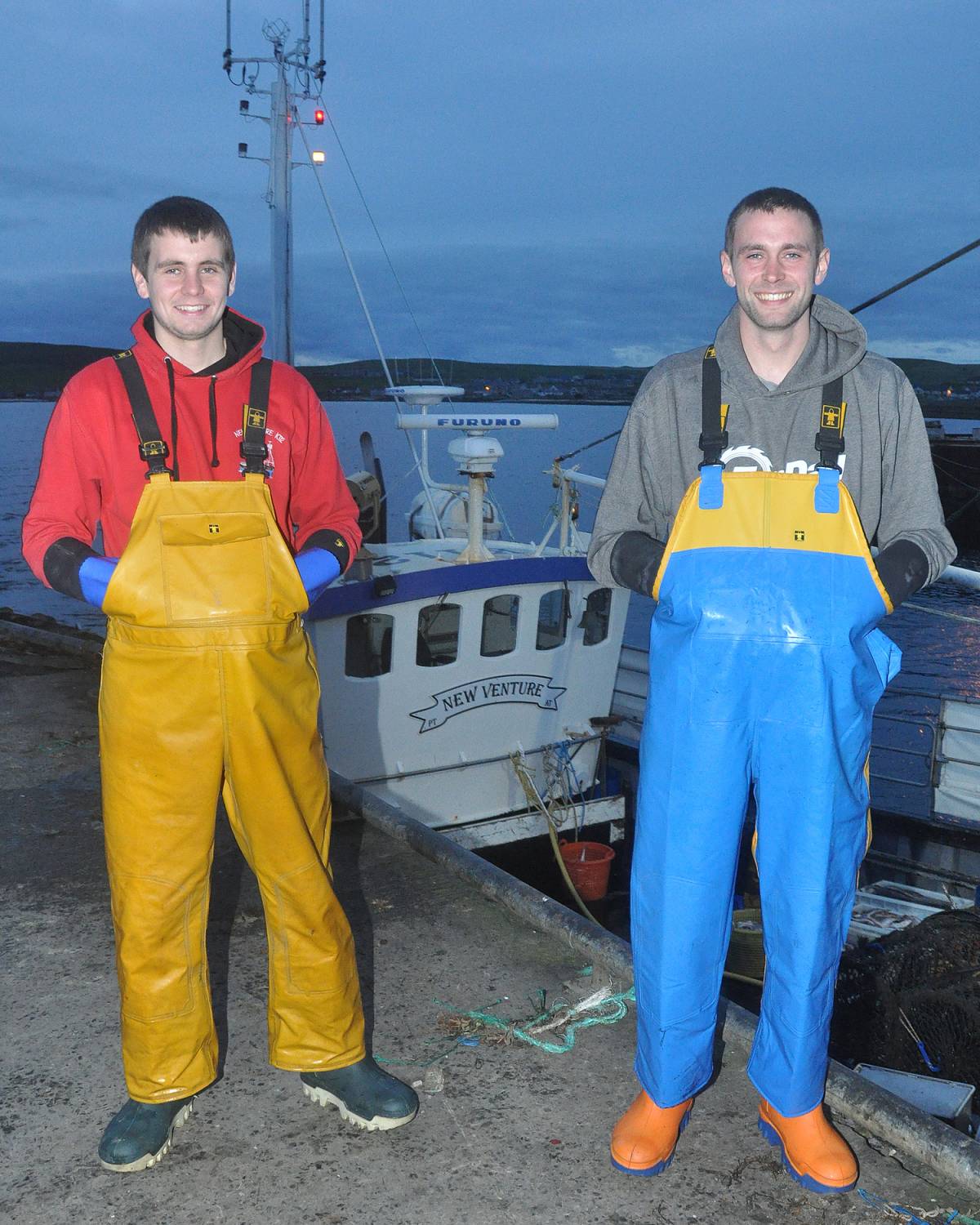
Young Westray brothers Adam and Paul Tulloch.

New Venture returning to Pierowall harbour.
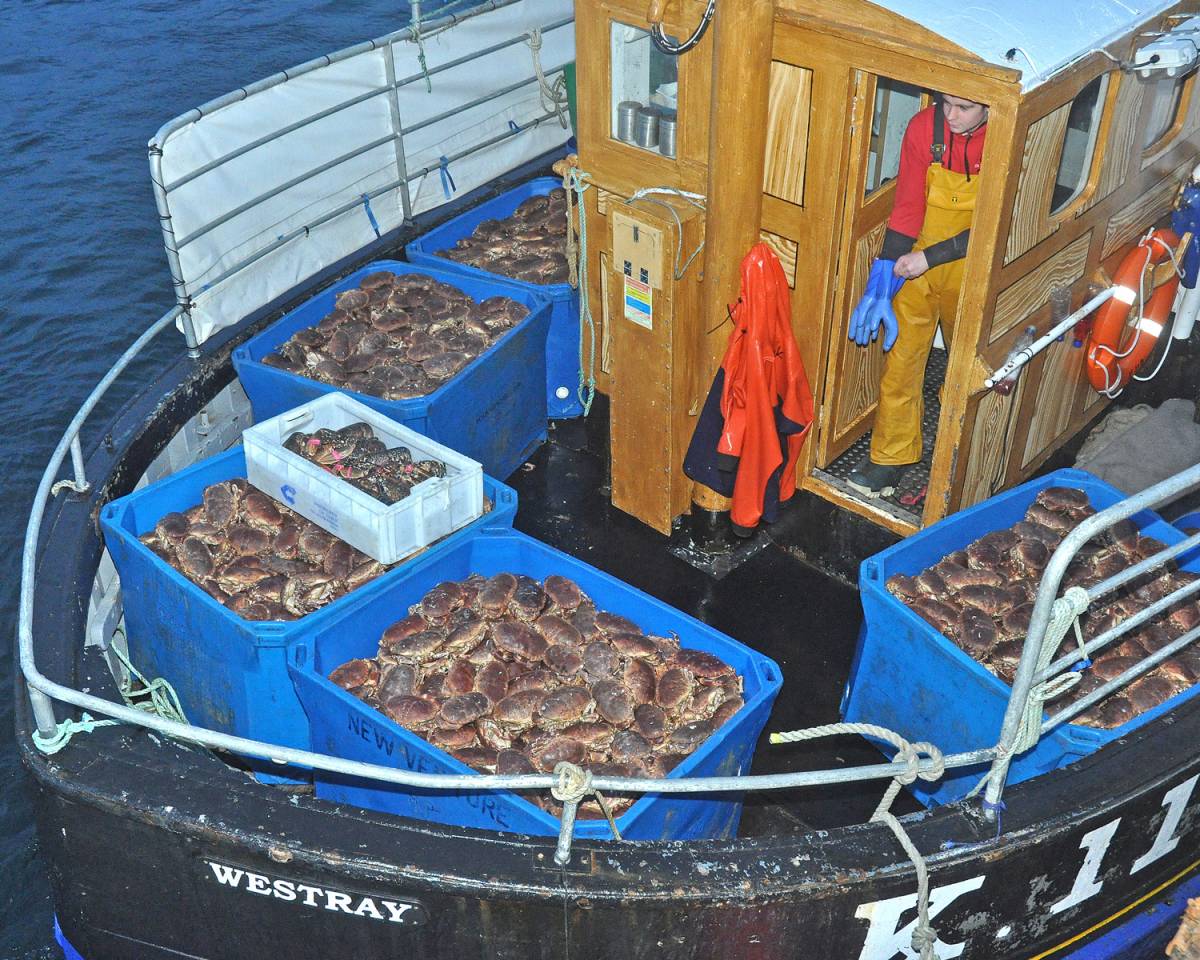
The catch of the day, ready to land.
Asked why they were so committed to crabbing, Adam and Paul immediately cited the continual action and intensity associated with fishing creels as being among the main reasons for their chosen career path.
The wooden-hulled New Venture previously fished from Sanday as Kelly T 427, when owned by skipper Ian Harcus. After Kelly T sank at the pier in a northerly storm, the crabber was extensively refurbished by Macduff Shipyards for Paul and Adam Tulloch.
Powered by a 172kW Gardner 8LBD main engine, New Venture was built by Hinks of Appledore, North Devon, as the vivier-crabber Belle Tout NN 422 for Newhaven skipper Peter Storey.
Westray Processors provides vital market continuity
Located at the head of Pierowall harbour, the local shellfish factory, Westray Processing Ltd, provides a constant and invaluable market for brown crabs caught by the local fleet.
It is difficult to overstate the hugely important role Westray Processors has in the small local community. In addition to being the biggest single employer on the island, with 28 staff handling an average 30t of brown crab a week, Westray Processors also provides the outlet for the daily supply of high-quality brown crab landed by locally-owned boats, which also provide vital work and career prospects for their skippers and crews.
In a small island community situated some 80 miles from northern Scotland, which clearly leads to challenging and expensive transport logistics, it would be difficult to envisage a continuing and sustainable shellfish fleet without the long-term presence and stability provided by Westray Processors.
As a co-operative, Westray Processors is owned by the people of Westray, most of whom, including all local creel skippers, contributed to the formation of the company in 1968 by either pledging money for shares or as loan capital, while others provided the labour to help construct the first phase of the factory in 1968.
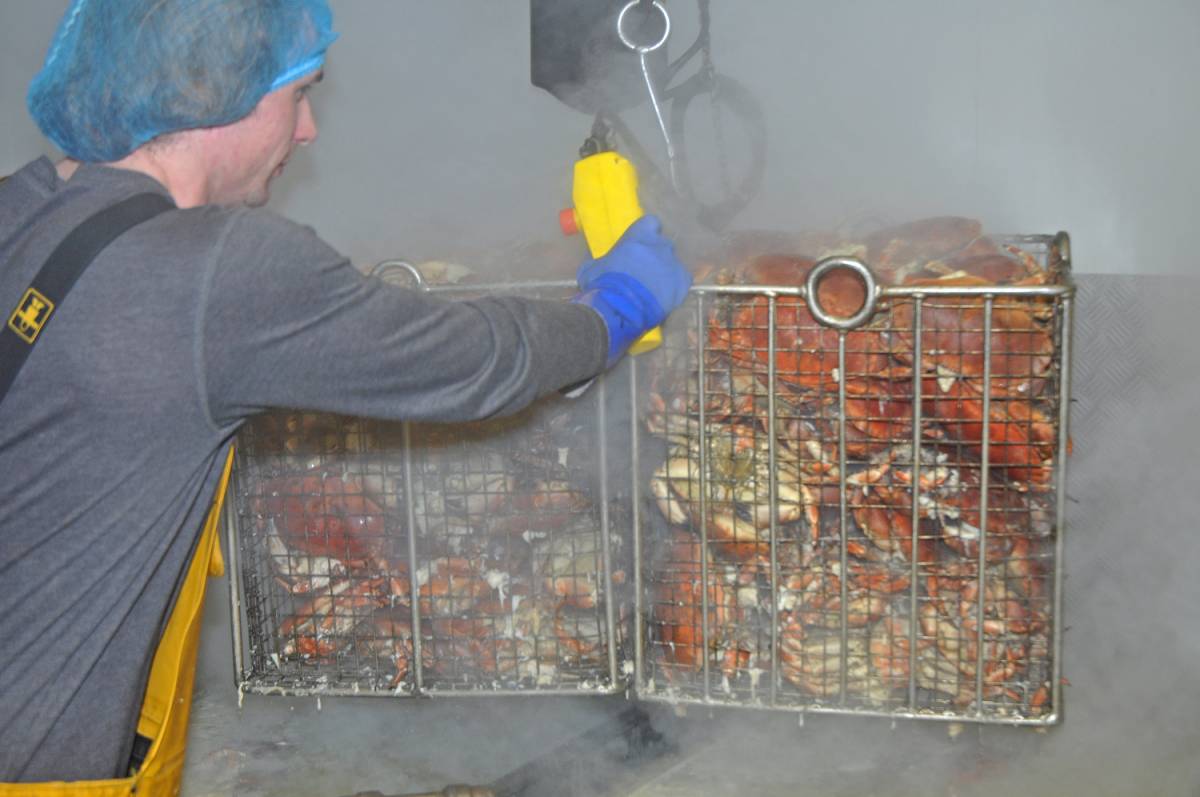
Removing two baskets of brown crab after boiling.
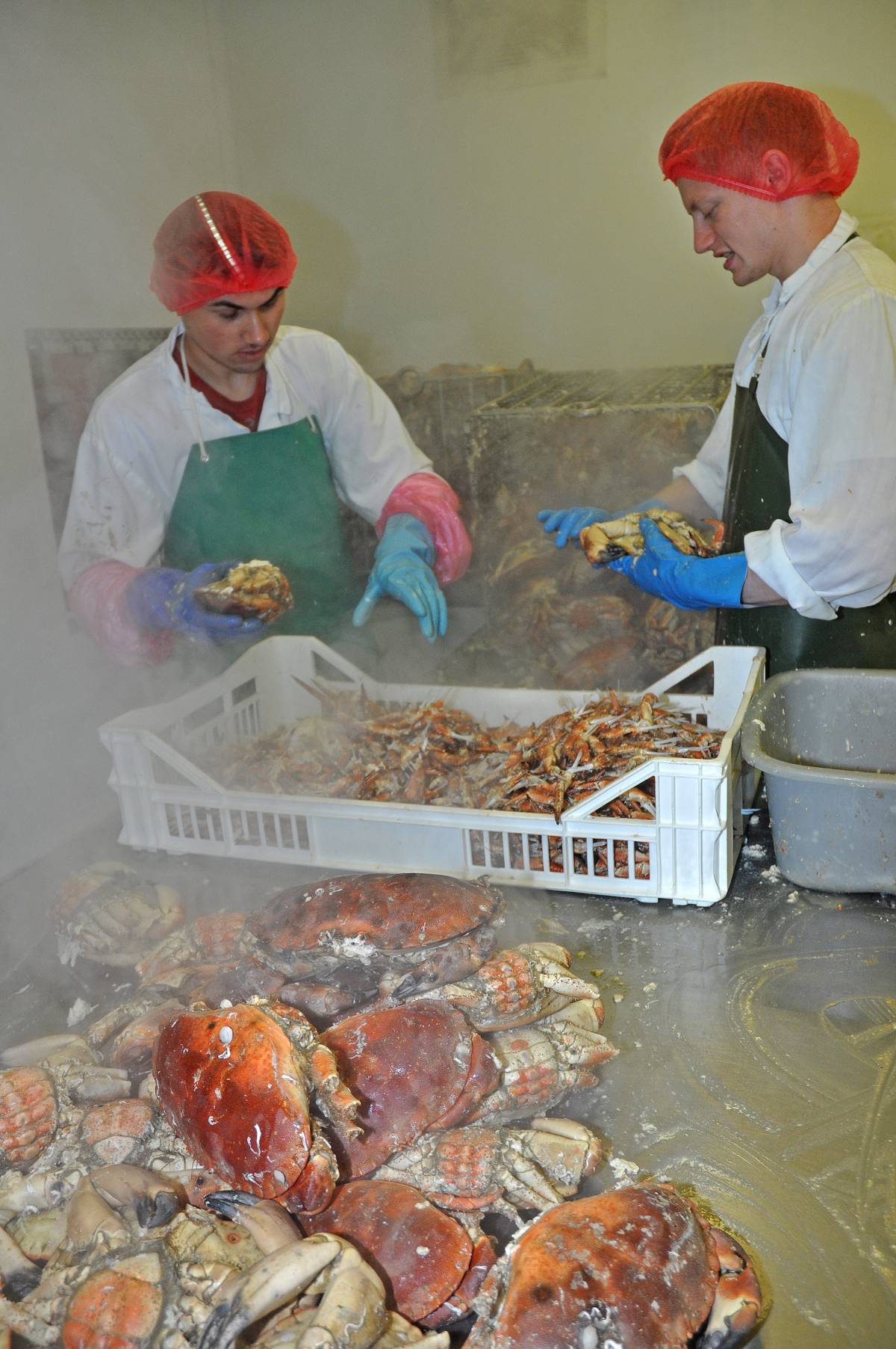
Staff begin to process brown crab.

Quality control is of paramount importance.
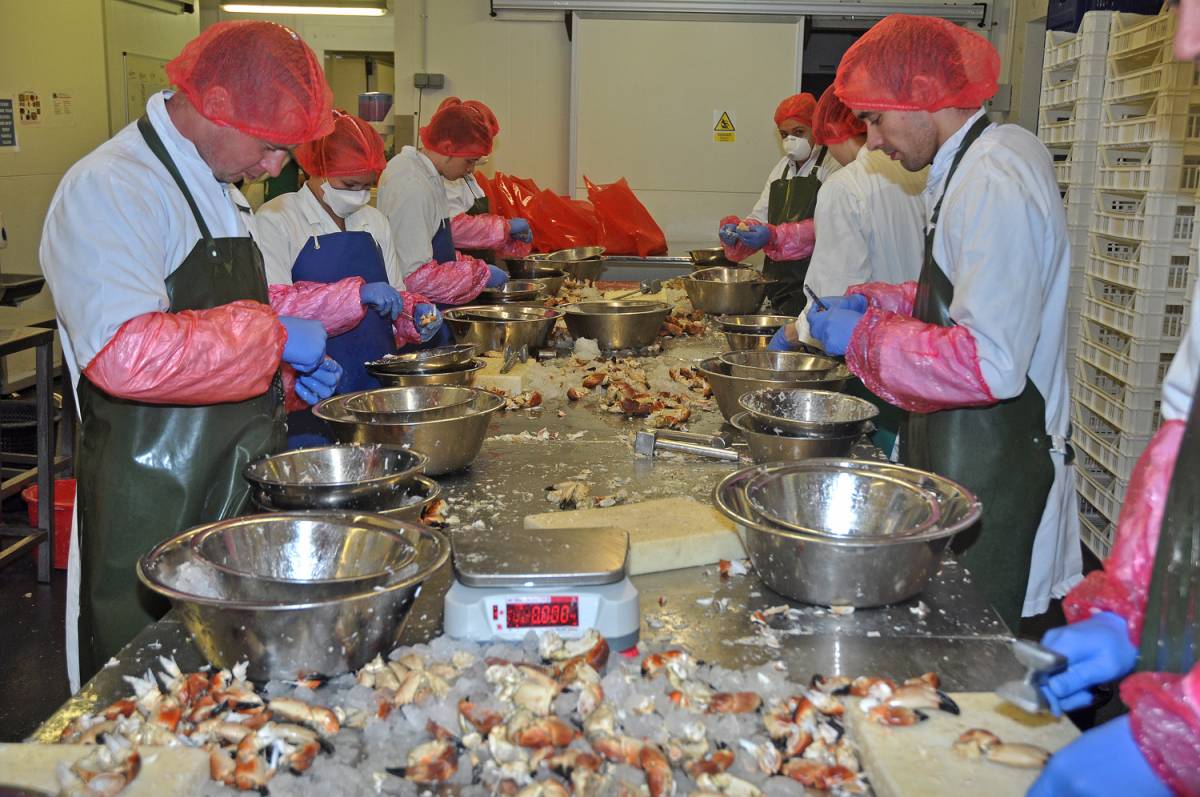
Hand picking white claw meat.
The original share capital, required from fishermen in order to be paid the full price for their crabs, was £50 per crewman. The early price paid for crab was six shillings (4.7p per kg) per stone. If fishermen could not afford the initial £50 they were paid 4/6 per stone (3.5p per kg), the other 1/6 (1.2p per kg) going towards their share.
At a time when there was still no mains electricity on Westray (two 30kW Lister 3-phase generators were purchased specifically for this purpose), building a factory that included a blast freezer, chilled storage area and a boiler room, clearly represented a major undertaking and a step into the unknown.
In the first year of operation, when the brown crab fishery undertaken in shallow inshore waters was of a short seasonal nature (May-June), 82t of brown crab were landed, rising to 225t in the second year. Since then, despite the almost inevitable difficulties and fluctuations that are considered part and parcel of crab processing, annual throughput overall has risen, (notwithstanding some dips in the road along the way).
In 2014, 604t of brown crab were processed, compared to 285t in 2001, as the factory continues to go from strength to strength.
Such steady progression is directly attributable to the loyalty of the factory workers, together with Westray fishermen, some of whom have supplied brown crab to the company for over 40 years.
Another factor in a long-running success story is the daily supply of top-quality Orkney brown crabs, which are landed on the pier in the early evening less than 100m from where they are drowned and boiled overnight, before being processed the following morning.

Westray Processors manager Denise Sturgon.
During the summer months in particular, high volumes of fresh brown crab are dressed ready to eat, before being distributed to hotels, restaurants, Bed and Breakfasts and retail shops throughout Orkney.
For the past two years, Westray Processors has been managed by Denise Sturgon, who has worked diligently with factory staff and fishermen to increase production levels across all timescales. A number of new initiatives put in place by Denise Sturgon to increase turnover, including in-house engineers to keep production continuing smoothly, are now proving to be of benefit to Westray crab fishermen.
Westray Processors also has a long history of co-operation with Orkney Fishermen’s Society, with the two co-operatives working closely at all times for the benefit of Orcadian fishermen and their families.
BEE – 111 and counting

The traditional South Isles yawl Bee was built on Burray in 1905.
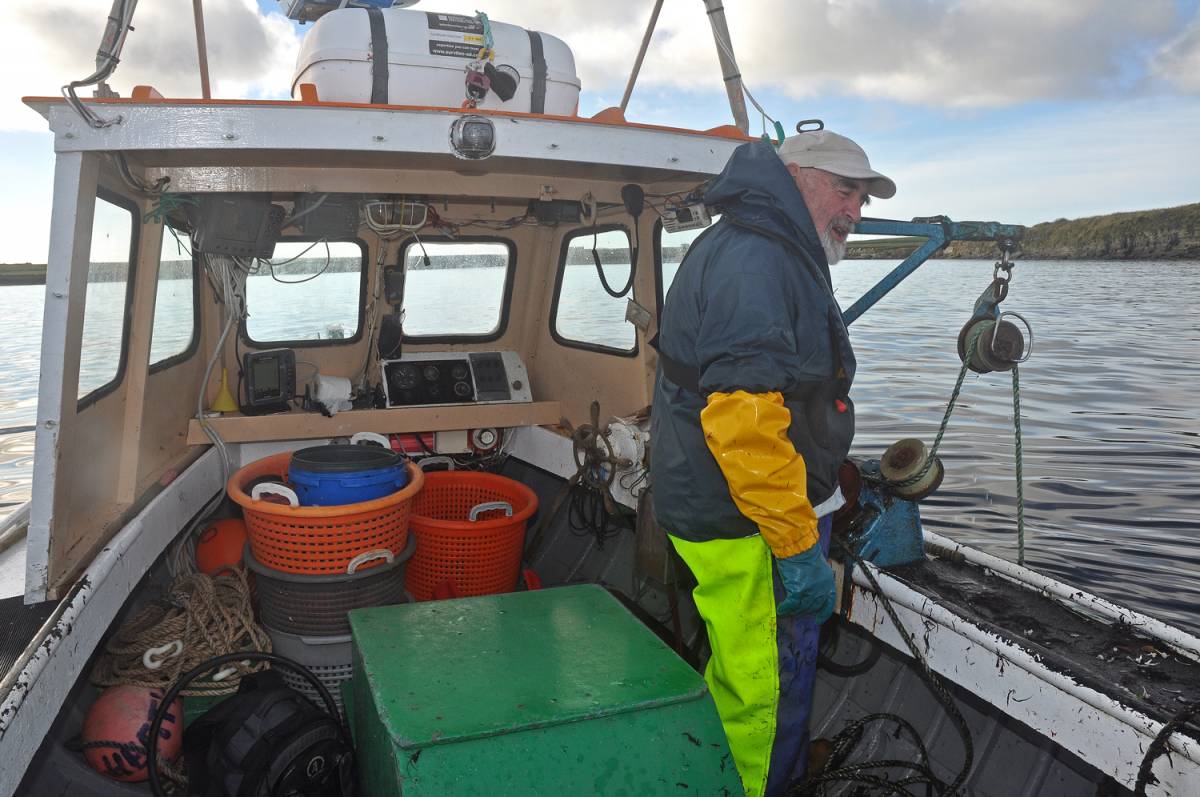
Geordie Costie hauling the first…
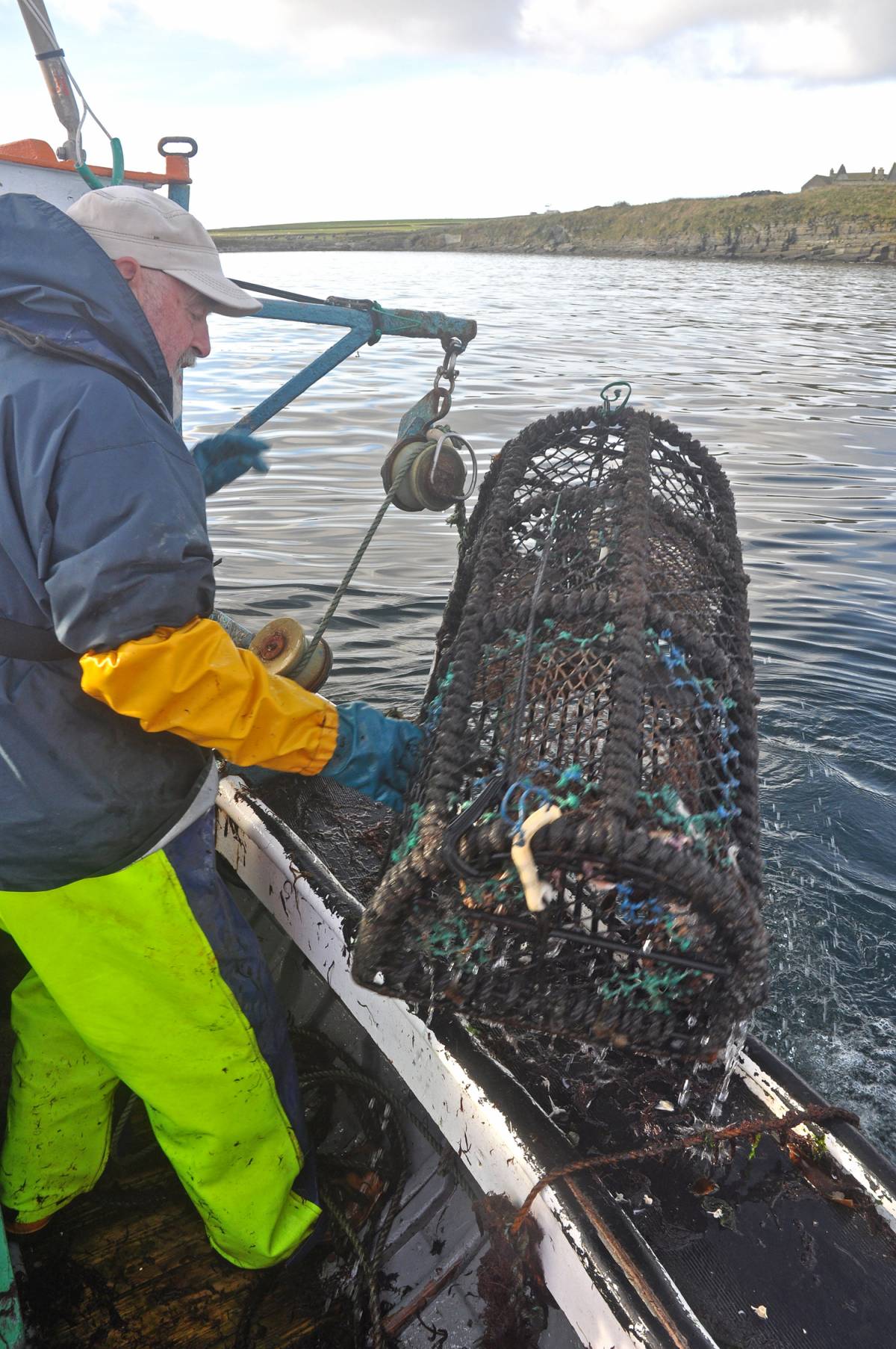
… single-ended parlour creel.
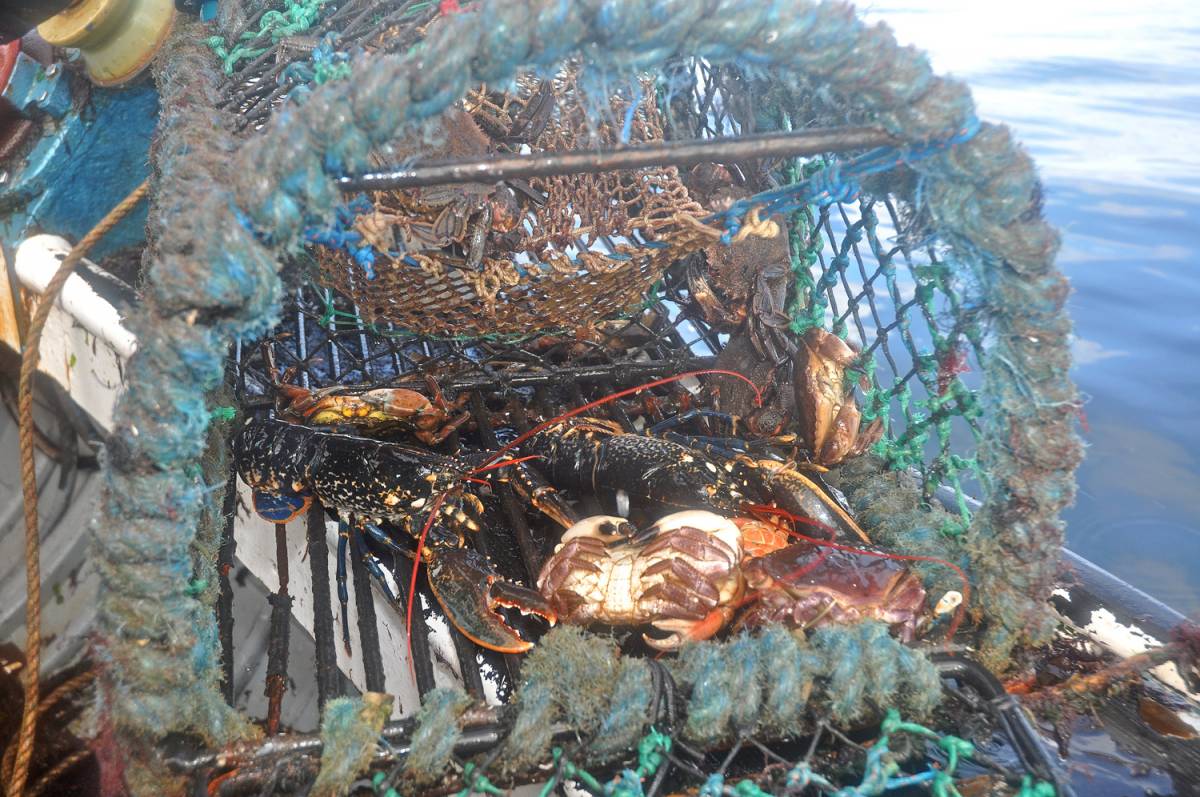
A well-mixed return from the shoreline.
Westray skipper Geordie Costie’s inshore creel boat Bee K 70 is now in her one-hundred-and-eleventh year of service.
Built in 1905 at the Duncan Boatyard on Burray, for a local crofter, the traditional South Isles yawl has the distinction of being one of the oldest commercial fishing boats in the UK today.
Bee shares a number of similarities to Stroma yawls, considerable numbers of which were built to fish in the notoriously turbulent tidal waters around the small island situated at the eastern side of the Pentland Firth, from which this traditional design of boat take their name.
Interestingly, when Bee was built with a LOA of 20ft and 7ft 6in of beam, the clinker-hulled boat was considered too big for lobster fishing – despite featuring a low freeboard to facilitate rowing. When new, Bee featured a jib and mainsail. This rig was later changed to a dipping lug.
Having started her life at the southern tip of Orkney, the yawl worked her way northwards through Orkney before Hugh Costie brought Bee to Westray in 1931. Since then, ownership of Bee has remained in the Costie family for 85 years.
After Bee sank on her moorings in during a severe storm in 1959, steamed Canadian rock elm frames were fitted between the yawl’s original oak frames, to provide a stronger structure for the larch planking.
When Bee arrived at Westray, the boat fished single-end lobster creels, before the use of back ropes grew in popularity, increasing the muscle power needed in the days of hand hauling.
Today, fitted with a forward wheelhouse, modern electronic equipment, Kubuto engine and a HydroSlave hauler on the starboard gunwale, Bee continues to earn its keep on a daily basis, by working parlour creels mainly for velvet crabs, although lobsters are always welcome.
Now slightly past retirement age, Geordie Costie fishes his gear as single-enders, when working single-handed up to 6-7 miles from Pierowall harbour. Manufactured by Caithness Creels of Wick, the 36-inch parlours are usually worked close to the rock shoreline, along the east side of Westray.
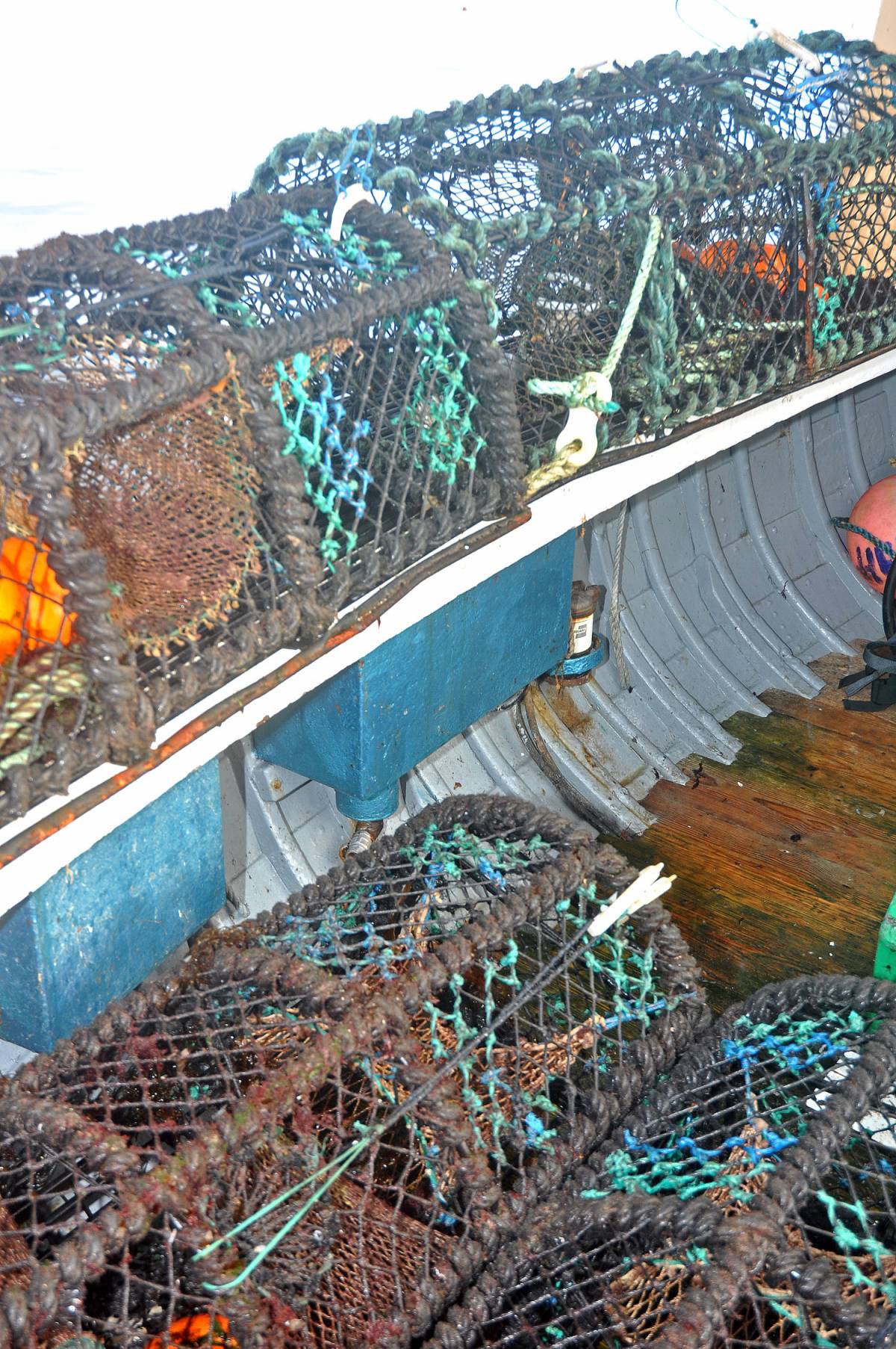
Bee’s combination of steamed Canadian rock elm frames fitted between the yawl’s original oak frames, are clearly shown as the parlours are stored along the side deck.
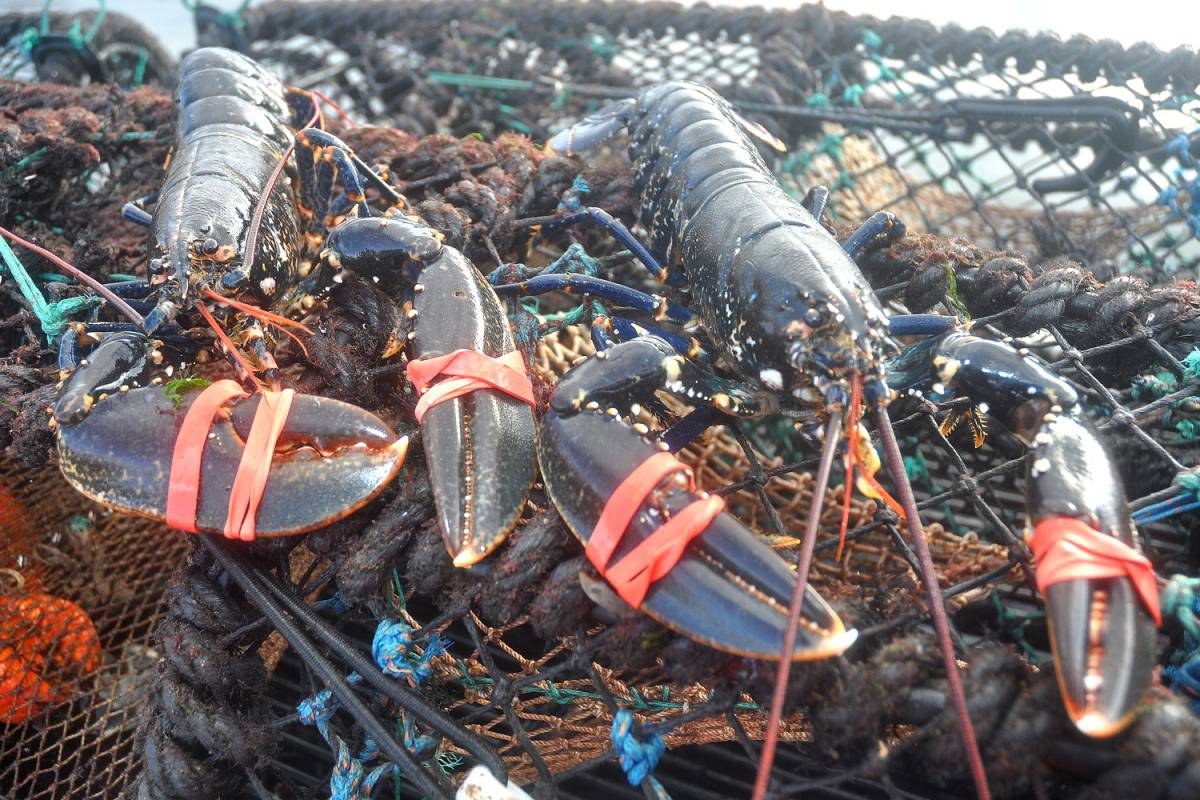
Bee’s last inshore lobsters of the year.
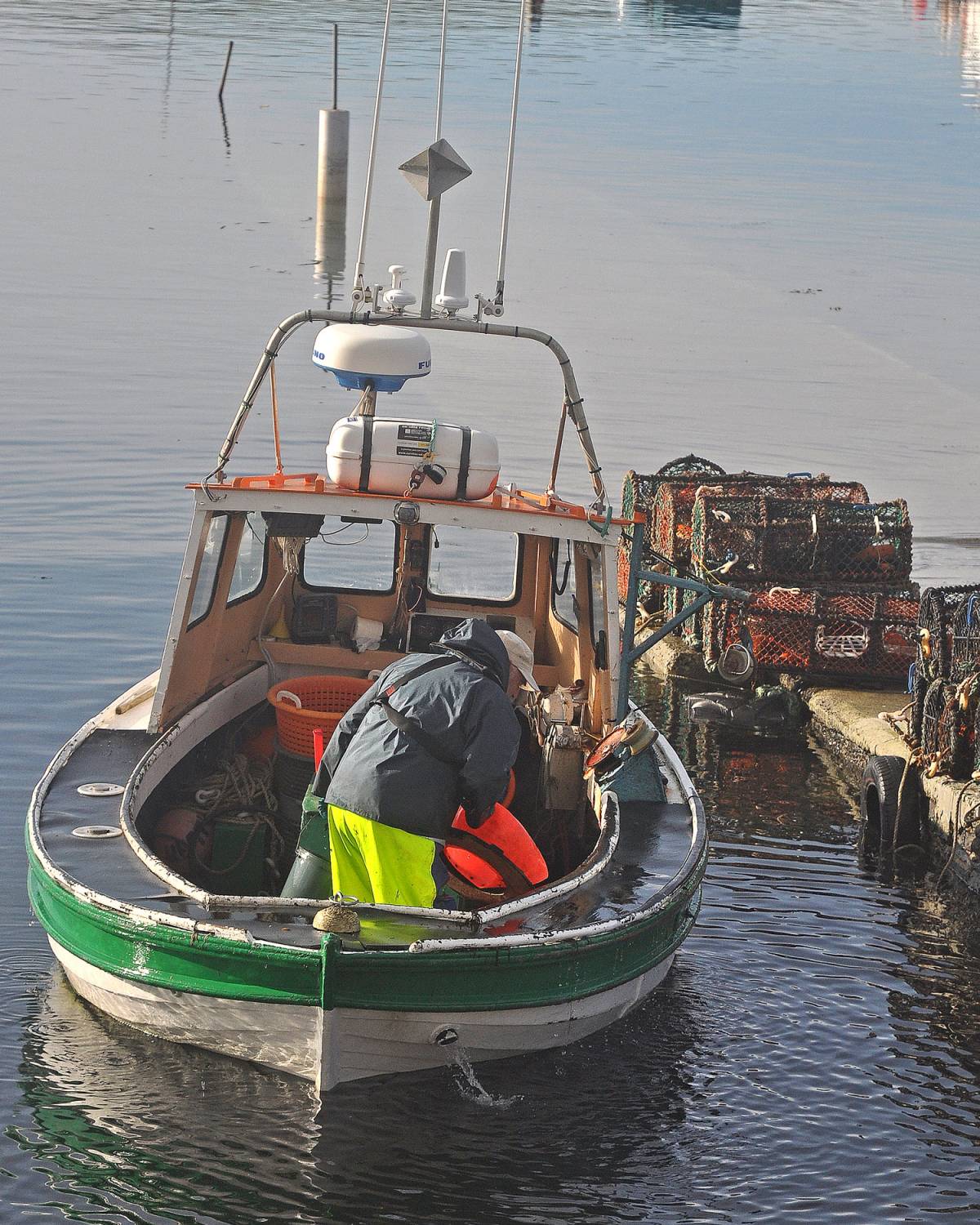
The classic stern lines of a South Isles yawl, as Bee edges away from the Pierowall slip after another seven parlour creels were put ashore.
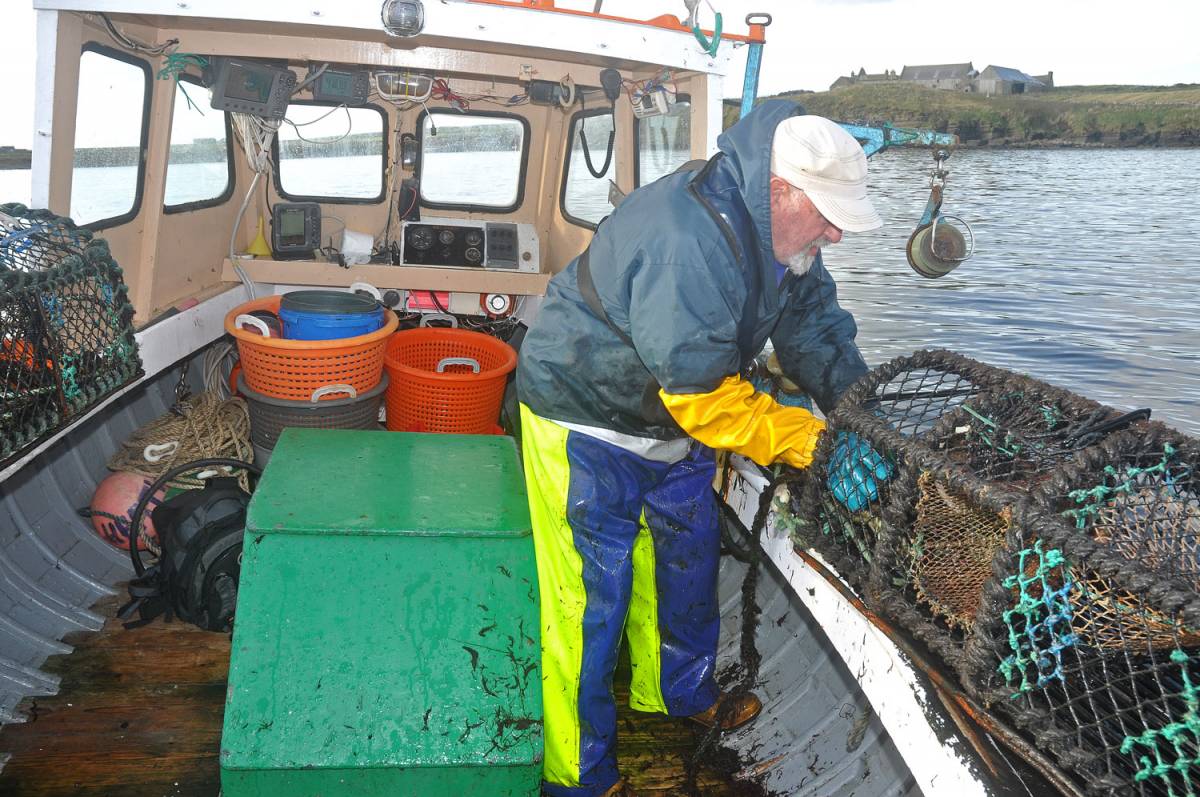
Geordie Costie places the single-ended tailing into a parlour.
Every morning, weather permitting, Geordie Costie puts a lifetime’s experience and local knowledge to good use in his ceaseless attempts to locate the nooks and crannies that on a good day can yield prime quality shellfish.
Given the opportunity to spend a couple of hours on Bee, on a beautiful tranquil morning in mid-October, as Geordie Costie was taking seven single-ended parlour creels ashore before they could be at risk from early winter gales, provided crystal clear evidence of the sense of purpose and fulfilment inshore fishing can provide on a good day, regardless of the age of skipper or boat.
As a mixture of crabs and lobsters were emptied from the parlours shot in 2-3 fathoms of water, a good showing of juvenile blues provided clear evidence of encouraging stock levels that will ensure the age-old tradition of lobster fishing in Orkney is maintained for future generations.
Thanks Geordie.
Westray whitefish fleet from years gone by
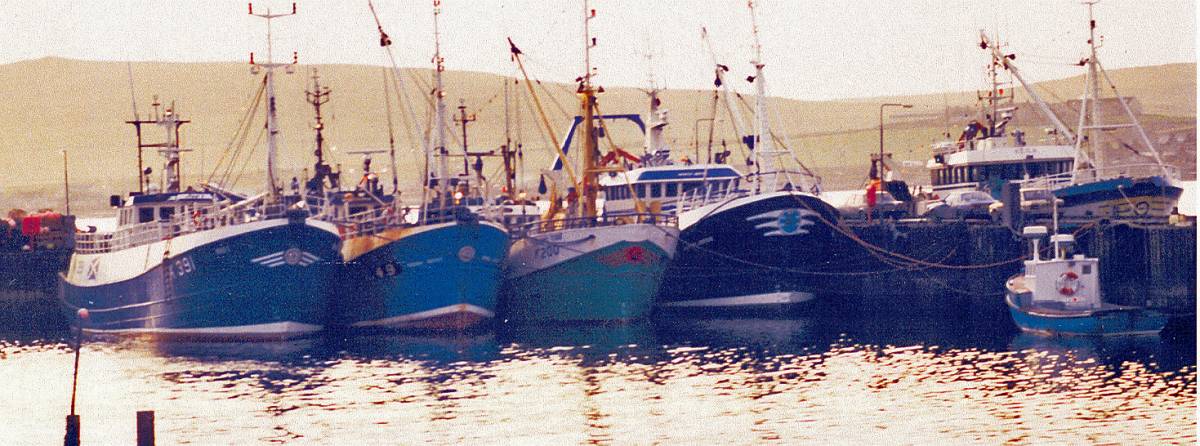
Pierowall in the early 1990s, with the modern whitefish trawlers Rivo 1, Orkney Reiver, Flowing Tide, Vesterfjord and Keila alongside.
Less than two decades ago, Pierowall skippers operated some of the most modern whitefish vessels in Britain, at a time when Westray boats formed the backbone of an Orkney fleet that had been built up in a relatively short period of time. Until the mid-1960s, fishing in Orkney was mainly combined with farming, by crofters using inshore static-gear boats.
From the early 1960s, an accelerated change of emphasis took place at Pierowall. In 1963 George and Alex Costie started to make a gradual transition from creels to seine-netting by buying the 56ft Chance WK 126 from Donnie MacKay of Wick. Chance was built by William Slater of Lossiemouth in 1934, as Avondale INS 193 for local skipper Alex Souter. Chance was joined the following year by the former Shetland 65ft herring drifter Enterprise LK 447, built by David Howarth of Scalloway in 1947 for Burra Isle skipper John Pottinger. The subsequent success of these, and other vessels, led to further expansion of the Westray fleet.

Sirius, Enterprise, Scottish Maid, Rivo and Bon Ami, berthed at Pierowall in the 1970s, were the forerunners of Westray’s modern fleet.
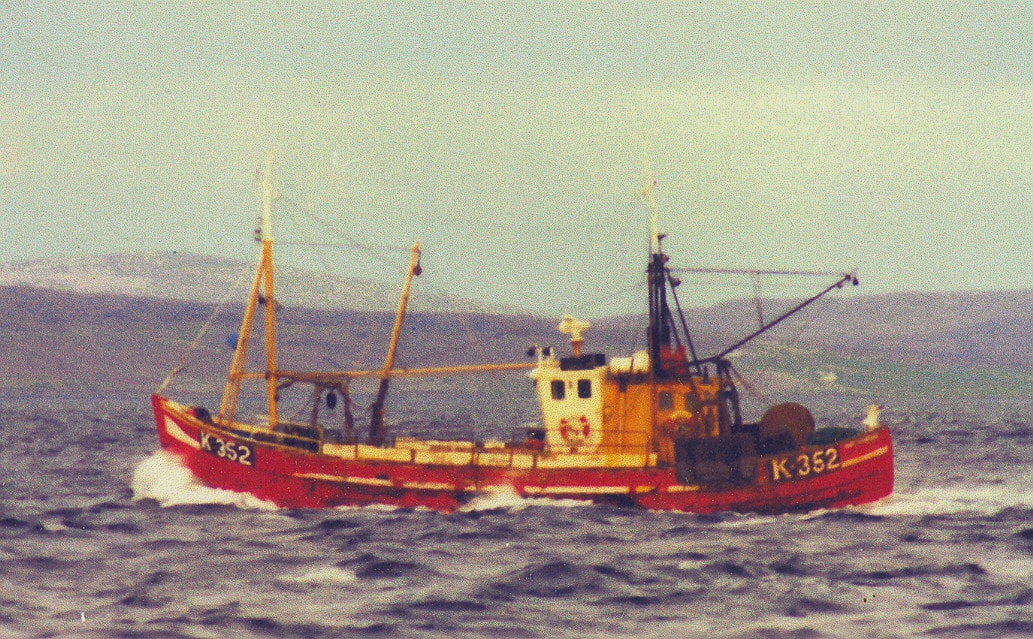
The former Bridlington trawler Our Katherine was Pierowall skipper Tam Harcus’s first boat.
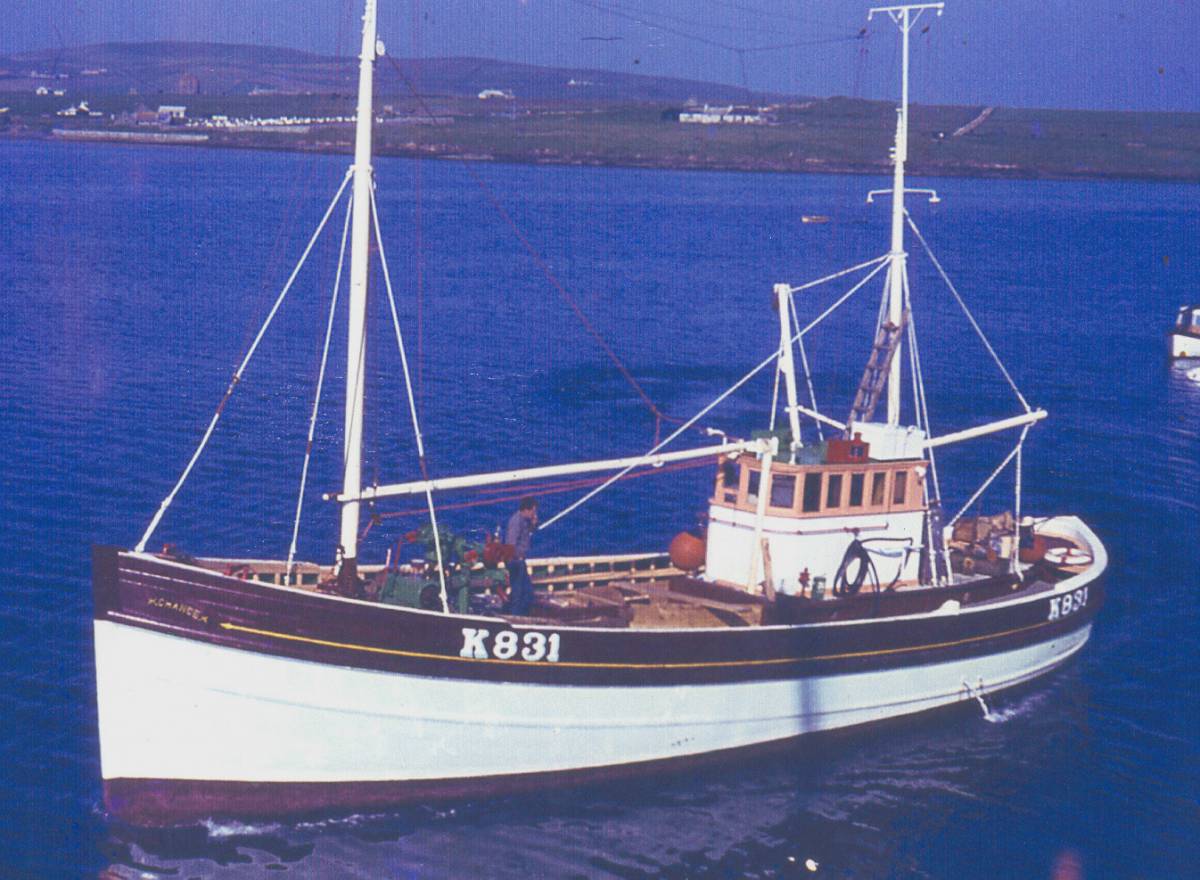
George and Alex Costie bought Chance to Pierowall in 1963, as the transition from fishing creels to seine-netting started.
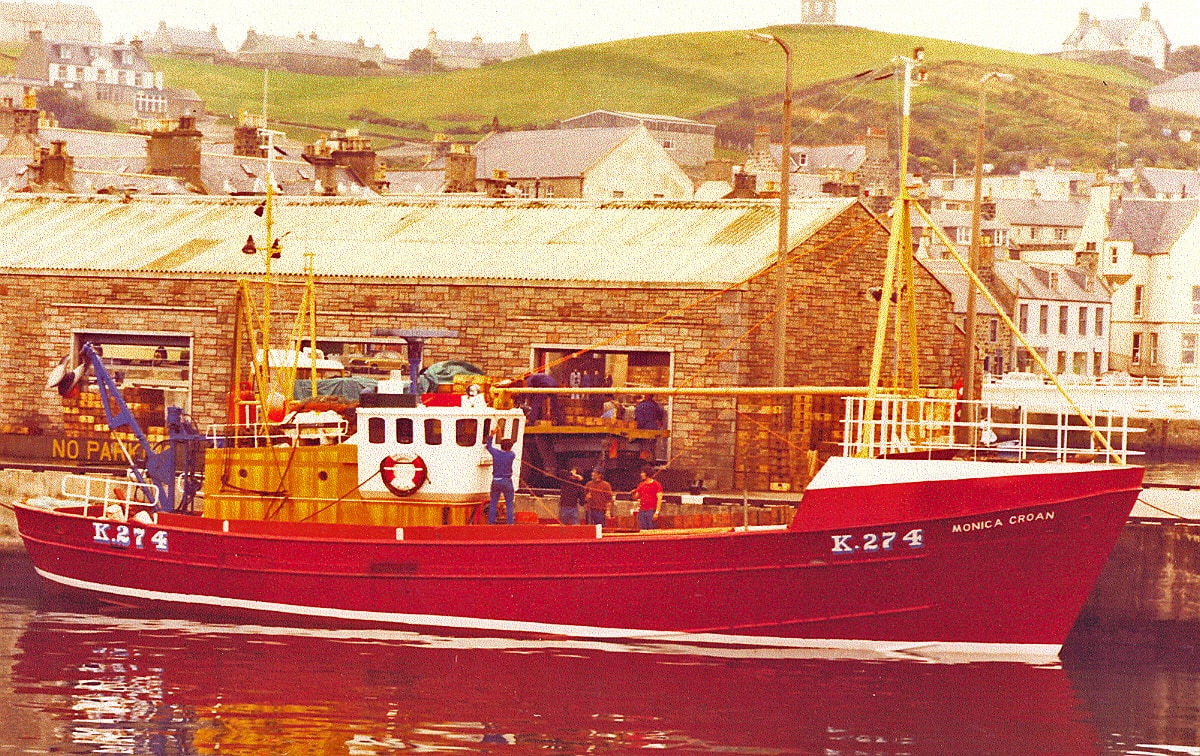
The Berwick-built Monica Croan joined the Westray fleet in 1974.
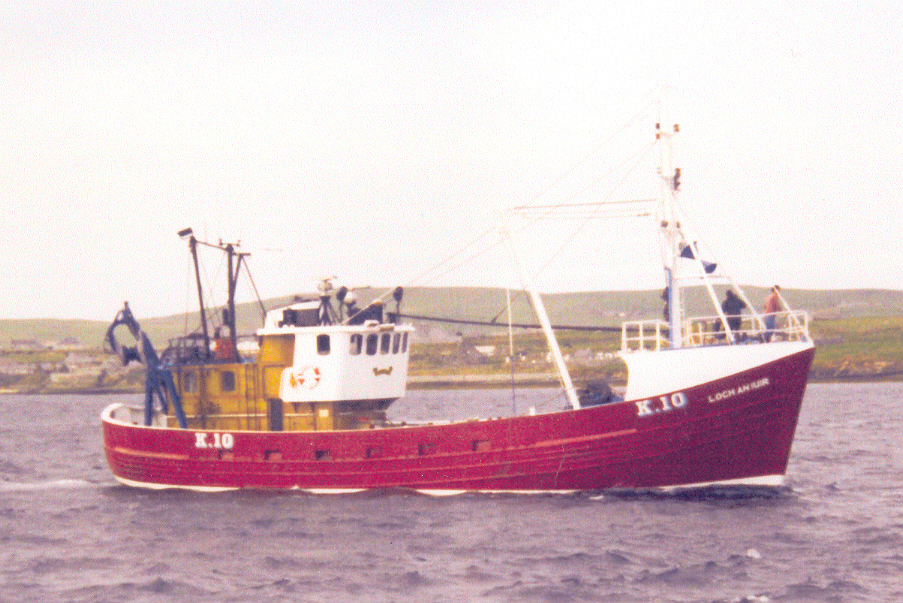
Loch an luir.
After buying the one-year-old Danish-built Elsie Risager from Whitehaven in 1972, which he renamed Alma K 245, Alex Costie subsequently bought Dauntless N 385 from Kilkeel. Featuring a 500hp Kelvin engine, this 78ft trawler was built during 1970, as Aquarius FR 55 by J & G Forbes of Sandhaven, for Rosehearty skipper James Slater, before becoming Dauntless INS 264. Re-registered Dauntless K 20 on arrival at Pierowall, this forward-engined boat was renamed Hebron FR 149 in 1987, when Alex Costie bought the purser Flowing Tide BF 200 and rigged the 105ft boat for whitefish trawling.
In 1974, Pierowall skipper Malcom Brown bought the 73ft Sputnik seiner/trawler Monica Croan LH 231, which was registered K 274 on arrival at Westray. Featuring a 152hp Gardner engine, this boat was built by Fairmile Construction Co Ltd at Berwick in 1959, for Joe Croan Ltd. Five years later Monica Croan was sold to Macduff to be renamed Endurance BF 100 on being replaced with the 75ft and 325hp Caterpillar-engined Sirius LK 172, built at Flekkekfjord, Norway in 1972 for Burra Isle skipper Ralph Pottinger. George Costie bought the seine-netter Bon Ami K 469 in 1979, from William Rendall of Holm, Orkney. Fitted with a 152hp Gardner engine, the 71ft Bon Ami INS 69 was built by Jones of Buckie in 1958 for Donnie Jack of Hopeman. Jimmy Leslie and partners bought the former herring drifter Scottish Maid from the Moray Firth. Having previously fished the former Bridlington trawler Our Katherine H 352, Tam and John Harcus, and Jimmy Bain, bought the 80ft Swedish-built wooden-hulled trawler Rivo. Willie Sandison and partners went to Ireland for the 65ft trawler Loch an Iuir K 10, which he later replaced with Resilient.
The success achieved by these boats encouraged local skippers to consider building bigger boats, with the support of the Orkney Islands Council, Seafish and the EU.
In 1983, Skipper Tam Harcus took delivery of the Orkney Reiver K 49, the first of a succession of steel trawlers built by Campbeltown Shipyard for Orkney skippers. After a protracted build, Jim Bain brought his new boat, Rivo 1 K 391, home from Cornwall in 1986. Malcolm Brown replaced Sirius with the 85ft trawler Vesterfjord K 274 from James N Miller in 1986, followed by the 90ft Nordfjordr K139 in 1989.
As skippers started to fish the deepwater west of Orkney, Albert and Davie Reid bought the 86ft Lowestoft-built River Dee BF 473 from Aberdeen, selling Mount Royal to Kenny Bain and the smaller Golden Quest to Eyemouth. In 1989 Tam Harcus had the 90ft Keila K 121 built in Norway by Eidsvik Skipsbyggeri in Uskedalen. This was the start of the final push for new boats, which resulted in three Campbeltown 87 fully-shelterdecked trawlers being built for Orkney. Delivered in 1990, Arkh Angell K 616 was the first, replacing Kenny Bain’s Mount Royal, followed two years later by Guardian Angell K 535 for Tam and Balfour Bain, who previously skippered Noronya K 485 and Girl Maureen K 100 respectively. Later, in 1991, William Sandison and Michael Lyall replaced Resilient K 90 with Inga Ness K 44.
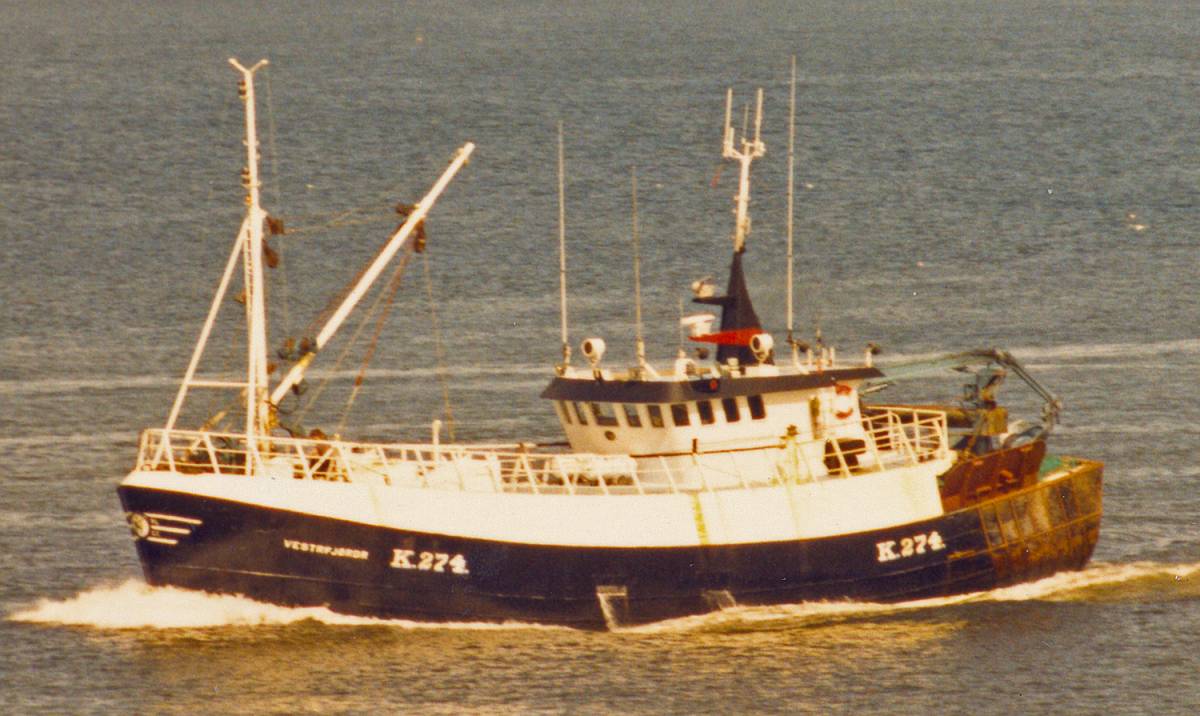
James N Miller built Vesterfjord…
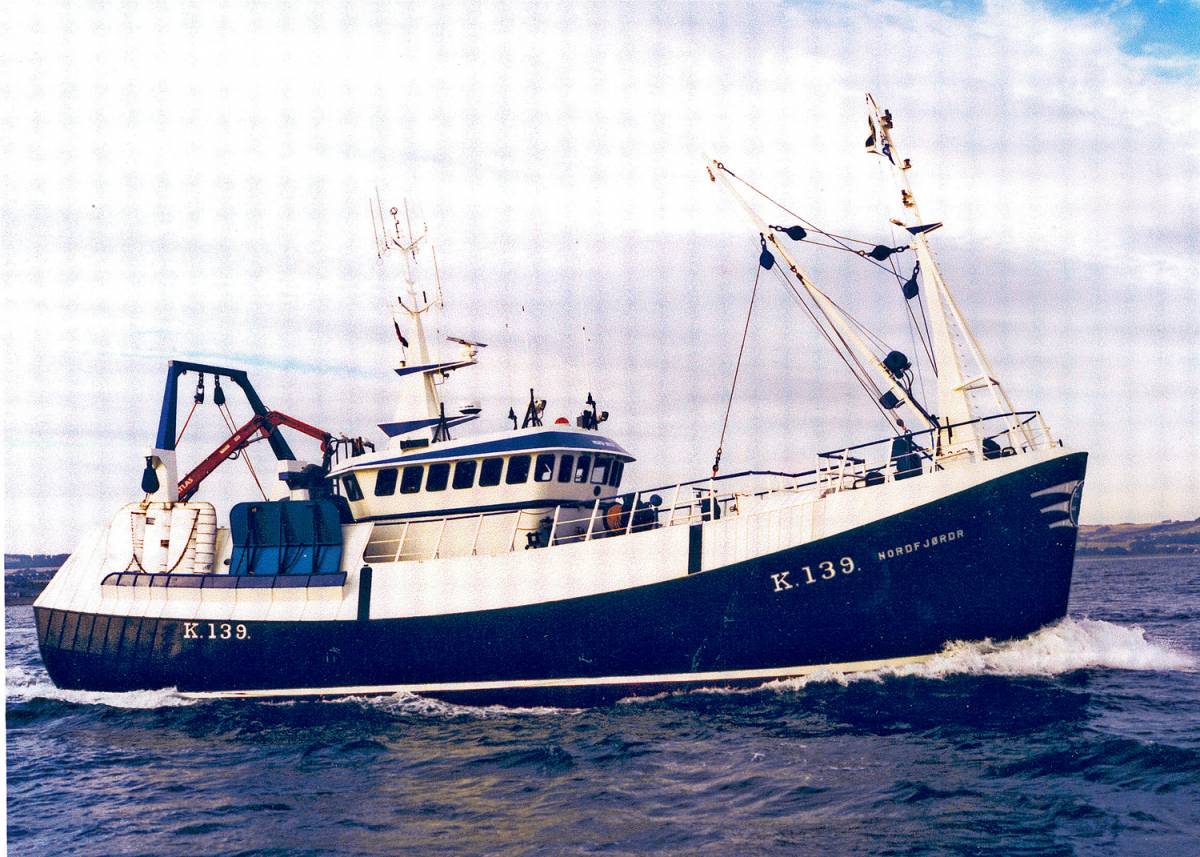
… and Nordfjordr for Pierowall skipper Malcolm Brown and partners.
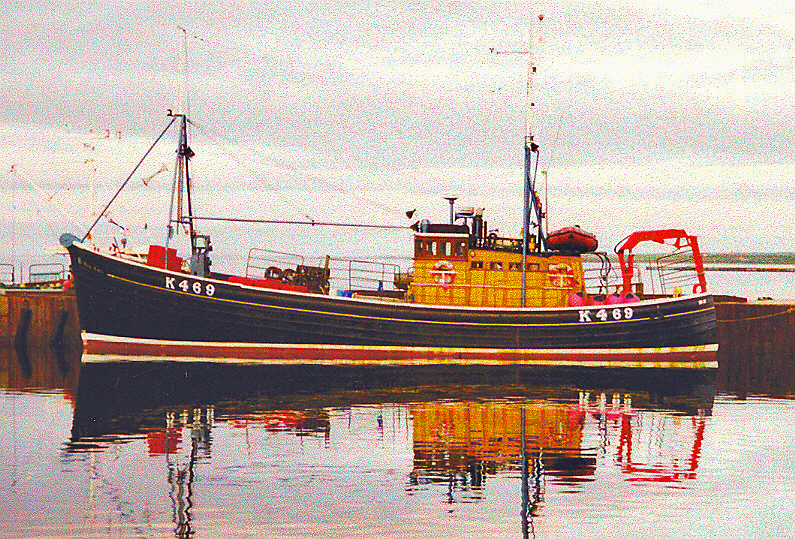
George Costie’s seine-netter Bon Ami.

The 80ft Swedish-built trawler Rivo.

Jim Bain’s Rivo I, punching into weather at Rockhall.
In the early 1990s, seven modern whitefish boats, Nordfjordr, Orkney Reiver, Vesterfjord, Keila, Rivo I, Flowing Tide and Inga Ness fished from Pierowall. Providing direct employment for 80 men, the Westray fleet made up half of Orkney’s 14-strong fleet of large whitefish vessels. This was a remarkable achievement for a fishing community not previously associated with whitefish. Most skippers had started virtually from scratch, without the benefit of gaining valuable experience on family boats.
When Tam Harcus took delivery in 1998 of the 34m deepwater stern trawler Russa Taign K 1102, built by Ailsa Troon, Orkney’s whitefish fleet had already started to diminish. Several vessels, including Vesterfjord and Nordfjordr, were sold to other Scottish ports, as quota cuts started to have a negative impact. At this time, few appreciated the speed at which the fleet would be cut in 2002-2003, when successive decommissioning schemes resulted in 50% of Orkney’s whitefish fleet being broken up.
Read more from Fishing News here.

